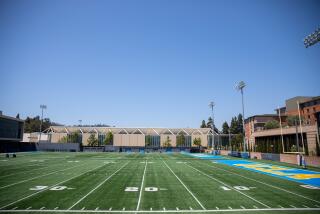High-Flying AirCal Begins Repayments to Employees
- Share via
Bouncing back from severe financial problems, AirCal Inc. plans to distribute $11.6 million to employees this week in the first of several payments to those workers who took a one-year, 10% salary cut in 1983 to help the Newport Beach-based airline keep flying, according to sources close to the company.
The repayment comes on the heels of AirCal’s report that in March it had jotted up yet another record-breaking month for passenger traffic. It was the 26th time in 27 months that the airline had posted historic monthly highs for the number of miles it had transported passengers.
Under terms of the employee wage cut, the airline promised workers that within eight years they would get back 150% of the salary they sacrificed. The $11.6 million will cover about 90% of that repayment, sources said. Only those workers who accepted the salary cut will be eligible to share in the funds. It was not immediately clear how many of the airline’s current 2,400 employees would share in the payment. The company had no comment on the expected payment but said it will be making a statement Monday.
Rising passenger and flight-mileage numbers reflect AirCal’s steadily improving financial footing. In a dramatic turnaround, it ended 1984 with an $8.5-million profit, the company’s first annual profit since 1981.
By contrast, when AirCal’s employees accepted 10% wage cuts two years ago, the airline was awash in red ink. It showed losses of $35.6 million in 1982 and $2.93 million in 1983. AirCal was hit by a prolonged recession in the airline industry shortly after it was acquired in 1981 by William Lyon, a major Southern California homebuilder, and George Argyros, owner of the Seattle Mariners baseball team and Arnel Development Co. of Santa Ana. Lyon and Argyros bought AirCal for $61.5 million at a bankruptcy auction after the collapse of the financial empire of its former parent company’s chairman, San Diego financier C. Arnholt Smith.
In December, 1982, at the end of a year in which AirCal sustained its biggest loss ever, Lyon took over the presidency of the company and initiated a new strategy, which included laying off 700 employees--more than a third of the airline’s workforce--and persuading the remainder to accept salary cuts.
AirCal changed its schedule to maximize flights on the profitable Los Angeles-San Francisco corridor and the company has made adjustments to respond to changing policies regarding noise and airline access at Orange County’s John Wayne Airport.
Over the past three years, Orange County’s airport commission has, under court order, reallocated a substantial portion of AirCal’s departure slots at John Wayne Airport to competing carriers. Between 1981 and 1985 the county slashed the number of AirCal’s allowed average daily departures at John Wayne from 23.5 to 12.5.
But last week AirCal added 3 new daily departures at John Wayne in response to the county’s lifting of the airport’s flight ceiling. Partly to take advantage of a bonus flight incentive that the county has offered airlines that meet low noise standards, AirCal has begun converting its entire fleet to quieter Boeing 737-300 jets.
After reaping revenue gains from its fare-discount program, AirCal last month began a $500,000 advertising campaign promoting an “Almost First Class” service between Los Angeles International and San Francisco International airports. By adding such amenities as more leg room, wider seats and fresh fruit and cheese, the airline hopes to lure customers away from PSA, its main competitor, and United Airlines.
So far, AirCal’s strategy appears to be working. In March, its jets flew 157 million revenue passenger miles, up 32% from 119 million revenue passenger miles in March, 1984. Passenger miles are the total number of miles flown by AirCal passengers.
One reason for the boost in traffic was the addition of planes and routes that expanded the airline’s available seat miles by 21.9%. Another reason was a 20.8% increase in passenger boardings, which numbered 379,730 in March, compared with 314,269 in the prior March. On average, AirCal jets in March flew 63.2% full, an increase of about 5 percentage points from the year-earlier period.
For the first quarter of calendar 1985, AirCal’s traffic was 21.4% greater than for the same period in 1984, with the airline posting 399.6 million revenue passenger miles. Seat miles rose 23.4% to 730.6 million and passenger boardings increased 14% to 1 million from 878,000. During the quarter, AirCal’s aircraft on the average flew 54.7% full, down from 55.6% during the same three months the prior year.
More to Read
Inside the business of entertainment
The Wide Shot brings you news, analysis and insights on everything from streaming wars to production — and what it all means for the future.
You may occasionally receive promotional content from the Los Angeles Times.










